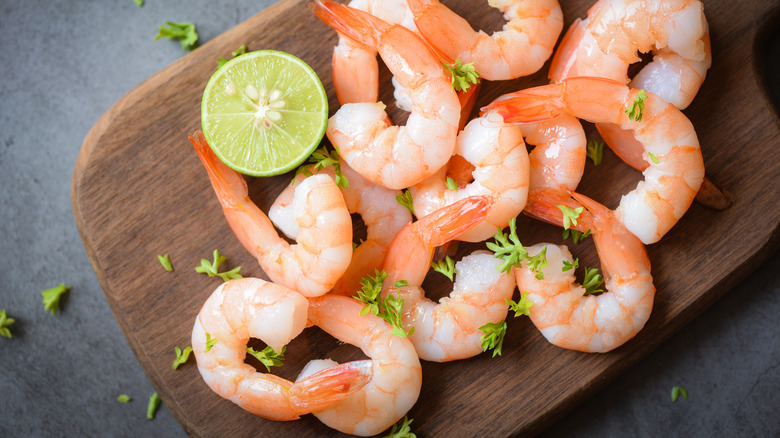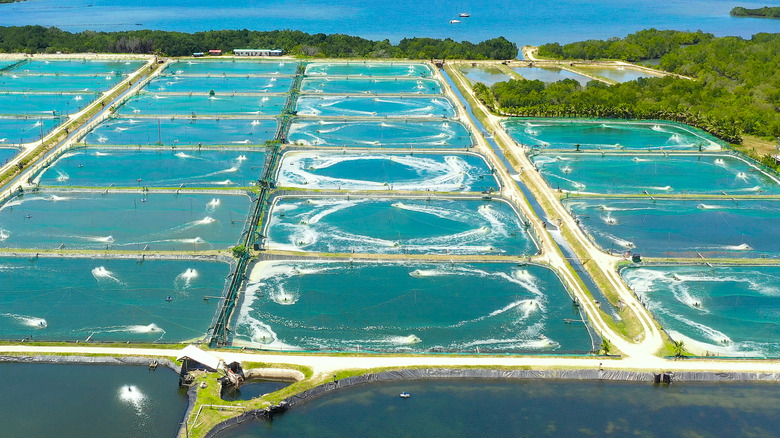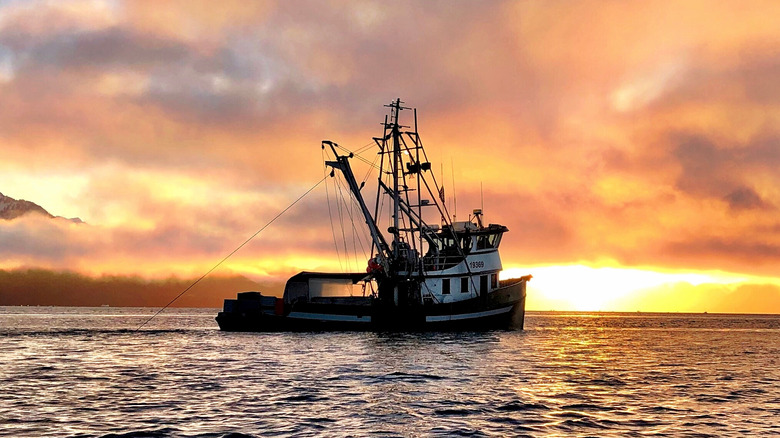The Real Difference Between Farmed Shrimp And Wild Shrimp
Correction 5/20/22: A previous version of this article stated that Global Seafood Alliance reported the use of antibiotics in farmed shrimp was rife. Global Seafood Alliance states that "many resort to the use of readily available antibiotics."
In recent decades, the seafood industry has experienced a sea change. Whereas consumers once took it for granted that the fish they were eating was wild-caught by fishing boats, nowadays, it's just as likely that the fish was sourced from aquaculture, or fish farms.
According to the Food and Agriculture Organization (FAO) of the United Nations, it's now estimated that half the seafood consumed worldwide is from aquaculture.
The increasing importance of aquaculture — a rapidly growing food sector, per the FAO — has certainly played a major role in the easy availability of shrimp for U.S. consumers. Fifty-five percent of the global shrimp supply comes from aquaculture, with much of it produced in Asian countries, including China, India, Thailand, Vietnam, and Indonesia.
Regardless of where the shrimp comes from, there's no question that Americans are eating it up. Per SeafoodSource, shrimp has been the most popular seafood choice for U.S. consumers in recent years. Shrimp is so popular, in fact, that Americans ate a whopping 4.4 pounds of it per capita in 2017.
Why should Americans care whether they eat wild or farmed shrimp? Learn the differences so you can make an informed decision.
The truth about farmed shrimp
As FoodPrint notes, there are sustainability issues with both farmed and wild-caught shrimp. With the former, these issues include the destruction of coastal mangrove habitats, which are often cleared for shrimp farming. The loss of these mangrove habitats negatively impacts coastal ecosystems and removes a natural defense in the event of hurricanes or storm surges.
But that's far from the only issue when it comes to farmed shrimp. As the Global Seafood Alliance reports many shrimp farmers use antibiotics, especially in Southeast Asia, where the majority of shrimp are farmed. Although the practice is undertaken to ensure healthy stocks of shrimp, it can have troubling consequences in a world where antibiotic-resistant pathogens are becoming increasingly more common because of the overuse of these drugs.
The biggest difference between wild-caught and farmed shrimp for most consumers, however, is taste. Because the ocean is the natural environment for shrimp, per Mmmediterranean, they're able to feed on their natural diet. As a consequence, wild shrimp usually taste better.
The truth about wild shrimp
Wild shrimp may taste better, but they come with their own concerns in terms of sustainability. The biggest issues are overfishing and bycatch — the unintentional catching of other seafood species — although, as FoodPrint observes, improvements to nets used in the Gulf of Mexico have helped reduce bycatch for domestic shrimp fisheries.
Consumers who value sustainability should pay close attention to labeling and certifications. The Marine Stewardship Council is the primary international certifier for sustainable wild fisheries, which is important, given that the U.S. imports 90% of the shrimp consumed by its citizens, per Food Print.
Of the five shrimp species commercially fished in the U.S., the National Oceanic and Atmospheric Administration (NOAA) Fisheries division reports that white shrimp, brown shrimp, brown rock shrimp, and pink shrimp are all being fished at sustainable levels, with regulations approved to minimize bycatch.
However, NOAA Fisheries notes that Atlantic northern shrimp are significantly below their target population numbers, so they're now prohibited from being fished.


